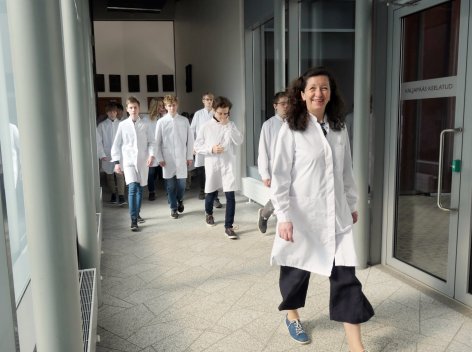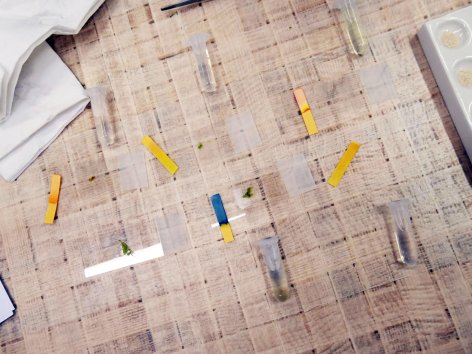-
Faculty of Arts and HumanitiesDean's Office, Faculty of Arts and HumanitiesJakobi 2 ruumid 116–121, 51005 Tartu linn, EST0Institute of History and ArchaeologyJakobi 2 51005 Tartu linn, Tartu linn, Tartumaa EST0Institute of Estonian and General LinguisticsJakobi 2, IV korrus 51005 Tartu linn, Tartu linn, Tartumaa EST0Institute of Philosophy and SemioticsJakobi 2, III korrus, ruumid 302-337 51005 Tartu linn, Tartu linn, Tartumaa EST0Institute of Cultural ResearchÜlikooli 16 51003 Tartu linn, Tartu linn, Tartumaa EST0Institute of Foreign Languages and CulturesLossi 3 51003 Tartu linn, Tartu linn, Tartumaa EST0School of Theology and Religious StudiesÜlikooli 18 50090 Tartu linn, Tartu linn, Tartumaa EST0Viljandi Culture AcademyPosti 1 71004 Viljandi linn, Viljandimaa EST0Professors emeriti, Faculty of Arts and Humanities0Associate Professors emeriti, Faculty of Arts and Humanities0Faculty of Social SciencesDean's Office, Faculty of Social SciencesLossi 36 51003 Tartu linn, Tartu linn, Tartumaa EST0Institute of EducationJakobi 5 51005 Tartu linn, Tartu linn, Tartumaa EST0Johan Skytte Institute of Political StudiesLossi 36, ruum 301 51003 Tartu linn, Tartu linn, Tartumaa EST0School of Economics and Business AdministrationNarva mnt 18 51009 Tartu linn, Tartu linn, Tartumaa EST0Institute of PsychologyNäituse 2 50409 Tartu linn, Tartu linn, Tartumaa EST0School of LawNäituse 20 - 324 50409 Tartu linn, Tartu linn, Tartumaa EST0Institute of Social StudiesLossi 36 51003 Tartu linn, Tartu linn, Tartumaa EST0Narva CollegeRaekoja plats 2 20307 Narva linn, Ida-Virumaa EST0Pärnu CollegeRingi 35 80012 Pärnu linn, Pärnu linn, Pärnumaa EST0Professors emeriti, Faculty of Social Sciences0Associate Professors emeriti, Faculty of Social Sciences0Faculty of MedicineDean's Office, Faculty of MedicineRavila 19 50411 Tartu linn, Tartu linn, Tartumaa ESTInstitute of Biomedicine and Translational MedicineBiomeedikum, Ravila 19 50411 Tartu linn, Tartu linn, Tartumaa ESTInstitute of PharmacyNooruse 1 50411 Tartu linn, Tartu linn, Tartumaa ESTInstitute of DentistryL. Puusepa 1a 50406 Tartu linn, Tartu linn, Tartumaa ESTInstitute of Clinical MedicineL. Puusepa 8 50406 Tartu linn, Tartu linn, Tartumaa ESTInstitute of Family Medicine and Public HealthRavila 19 50411 Tartu linn, Tartu linn, Tartumaa ESTInstitute of Sport Sciences and PhysiotherapyUjula 4 51008 Tartu linn, Tartu linn, Tartumaa ESTProfessors emeriti, Faculty of Medicine0Associate Professors emeriti, Faculty of Medicine0Faculty of Science and TechnologyDean's Office, Faculty of Science and TechnologyVanemuise 46 - 208 51003 Tartu linn, Tartu linn, Tartumaa ESTInstitute of Computer ScienceNarva mnt 18 51009 Tartu linn, Tartu linn, Tartumaa ESTInstitute of GenomicsRiia 23b/2 51010 Tartu linn, Tartu linn, Tartumaa ESTEstonian Marine Institute0Institute of PhysicsInstitute of ChemistryRavila 14a 50411 Tartu linn, Tartu linn, Tartumaa EST0Institute of Mathematics and StatisticsNarva mnt 18 51009 Tartu linn, Tartu linn, Tartumaa EST0Institute of Molecular and Cell BiologyRiia 23, 23b - 134 51010 Tartu linn, Tartu linn, Tartumaa ESTTartu ObservatoryObservatooriumi 1 61602 Tõravere alevik, Nõo vald, Tartumaa EST0Institute of TechnologyNooruse 1 50411 Tartu linn, Tartu linn, Tartumaa ESTInstitute of Ecology and Earth SciencesJ. Liivi tn 2 50409 Tartu linn, Tartu linn, Tartumaa ESTProfessors emeriti, Faculty of Science and Technology0Associate Professors emeriti, Faculty of Science and Technology0Institute of BioengineeringArea of Academic SecretaryHuman Resources OfficeUppsala 6, Lossi 36 51003 Tartu linn, Tartu linn, Tartumaa EST0Area of Head of FinanceFinance Office0Area of Director of AdministrationInformation Technology Office0Administrative OfficeÜlikooli 17 (III korrus) 51005 Tartu linn, Tartu linn, Tartumaa EST0Estates Office0Marketing and Communication OfficeÜlikooli 18, ruumid 102, 104, 209, 210 50090 Tartu linn, Tartu linn, Tartumaa EST0Area of Vice Rector for DevelopmentCentre for Entrepreneurship and InnovationNarva mnt 18 51009 Tartu linn, Tartu linn, Tartumaa EST0University of Tartu Natural History Museum and Botanical GardenVanemuise 46 51003 Tartu linn, Tartu linn, Tartumaa EST0International Cooperation and Protocol Office0University of Tartu MuseumLossi 25 51003 Tartu linn, Tartu linn, Tartumaa EST0Area of RectorRector's Strategy OfficeInternal Audit OfficeArea of Vice Rector for Academic AffairsOffice of Academic AffairsUniversity of Tartu Youth AcademyUppsala 10 51003 Tartu linn, Tartu linn, Tartumaa EST0Student Union OfficeÜlikooli 18b 51005 Tartu linn, Tartu linn, Tartumaa EST0Centre for Learning and TeachingArea of Vice Rector for ResearchUniversity of Tartu LibraryW. Struve 1 50091 Tartu linn, Tartu linn, Tartumaa EST0Grant Office
Students at Science Olympiad Practiced Studying the Atmosphere of Venus

In the final round of the Estonian Science Olympiad held last Saturday, students prepared to study the habitability of Venus' atmosphere. The competition tasks were inspired by the sensors being developed at the Tartu Observatory of the University of Tartu for the international Venus research project Venus Life Finder (VLF).
In the final competition of the Science Olympiad, 45 primary school students invited from all over Estonia performed experiments to determine acidity and assess its effects in the study laboratories of Chemicum of the University of Tartu. In the experiment, students had to build an LED-based luminaire that could be used to excite the fluorescent pigment fluorescein. Then they determined the acidity of two unknown samples using this method.

"The tasks simulated the process we use for developing a sensor to differentiate the acidity of Venus cloud droplets at the Tartu Observatory," explained Mihkel Pajusalu, chairman of the jury. He is also the head of the space technology department at the UT Tartu Observatory and manages Estonia's participation in the VLF. For the safety of the students, the concentrated sulfuric acid droplets actually found in the clouds of Venus were left out of the final round of experiments. The second experiment examined how plants adapt in an acidic environment based on plant tissues.
The VLF is a set of missions designed to study the conditions in the clouds of Venus to see if life could exist there. The project is led by the Massachusetts Institute of Technology (MIT) in the USA. More about Estonia's participation can be read HERE. The mission is also unique in that it is led and funded mainly by private companies unlike conventional missions led by space agencies. For example, the feasibility study for the mission was funded by the Breakthrough Initiatives in the US. The acidity sensor, the conductivity sensor, and the oxygen sensor will be built for this project at the UT Tartu Observatory. Three missions are planned for VLF, the first of which will start in 2023. The sensors being developed at the University of Tartu should take off in 2026.
Rasmus Randmäe, a student of Gustav Adolf Gymnasium, had the most successful results in Saturday's final round. But Raul Pata from Gustav Adolf Gymnasium became the overall winner of the Estonian Science Olympiad since both the regional competition and the final round are summed up. In next place were Kirke Arukaevu, a student of Tallinn 21st School, and Ivan Ducat from Narva Language Lyceum. Jan Hendrik Järvemets from Pärnu May School won the youngest age group, i.e., the 7th grade. The results of the final and general competitions are published on the website of the University of Tartu Science School.

The Science Olympiad, held every academic year, is intended for 7th and 8th-grade students. Any student 15 or younger can also participate. The Science Olympiad was funded by the Ministry of Education and Research and coordinated by the University of Tartu Science School. The main long-term sponsor of the competition is Graanul Invest. The competition is held in cooperation with the Research Laboratory of the University of Tartu and the Tartu Observatory. UT Tartu Observatory works with the space education of school students more broadly, for example, it participates in the joint project supporting general education, ESERO, organized between the European Space Agency (ESA) and local partners and organizes the Teadusmalev.

Additional information: Mihkel Pajusalu, Chairman of the Jury of the Estonian Science Olympiad, Head of the Space Technology Department of the Tartu Observatory of the University of Tartu, and Associate Professor of Space Technology, mihkel.pajusalu@ut.ee


